A living space is more than just an area to reside; it’s a canvas where our daily lives unfold. The art of arranging this space plays a crucial role in how we experience our home. It’s not just about placing furniture and decor; it’s about creating an environment that reflects our personality, promotes comfort, and enhances our quality of life.
A well-arranged living space can transform our daily routines into experiences. It can turn a simple morning coffee into a serene moment, or an evening with friends into a memorable gathering. The arrangement of furniture, choice of colors, and even the flow of natural light contribute to this harmonious experience.
The Couch: A Centerpiece of Living Room Aesthetics

At the heart of this living space is often the couch. More than just a piece of furniture, a couch is the centerpiece around which the rest of the room often revolves. Its placement, style, and comfort level set the tone for the entire living room. The couch is where we gather with loved ones, indulge in leisurely activities, or simply find solace after a long day.
In terms of aesthetics, the couch is a statement piece. It can be a splash of color in a neutral room, a sleek modern touch in a traditional setting, or a cozy, plush haven in a minimalist space. The choice of a couch speaks volumes about the room’s character and, by extension, about those who inhabit the space.
A well-chosen couch enhances the beauty and functionality of a living room. It dictates the arrangement of other furniture pieces, like coffee tables and armchairs, creating a cohesive and inviting environment.
To better understand the role of a couch in living room aesthetics, let’s consider some key points:
- Style and Comfort: A couch should be both stylish and comfortable, serving as a welcoming spot for relaxation.
- Size and Placement: The size of the couch should complement the room, and its placement should encourage a natural flow of movement.
- Color and Texture: The couch’s color and texture should harmonize with the room’s overall color scheme and design theme.
- Functionality: It should cater to the needs of the household, whether it’s for hosting guests, family movie nights, or quiet reading sessions.
The way we arrange our furniture, with the couch taking center stage, is more than a mere task; it’s a creative process that shapes our living experience. The right arrangement can turn a house into a home, a room into a sanctuary. It’s where comfort meets style, and functionality meets aesthetics, all harmonized to enhance our everyday life.
< class="wp-block-separator has-alpha-channel-opacity"/>Understanding Your Space

The Role of Room Size and Shape
The size and shape of your room are the foundation of your furniture arrangement. They dictate not just what furniture you can fit in, but also how it can be arranged for aesthetics and functionality. A large, spacious room offers more flexibility but can feel empty if not arranged thoughtfully. Conversely, a small room requires more strategic planning to avoid a cramped or cluttered look.
Consider these factors:
- Room Shape: Square, rectangular, or irregularly shaped rooms each have unique potentials and challenges.
- Room Size: Large rooms can be segmented into multiple functional areas, while small rooms benefit from multi-functional furniture.
Focal Points: Anchors of Your Room
Focal points are elements that immediately draw the eye when entering a room. They could be architectural, like a fireplace or a large window, or functional, like a television. The placement of furniture, especially the couch, should complement these focal points, not compete with them.
Key aspects of focal points:
- Natural Focal Points: Use existing architectural features like fireplaces or windows.
- Created Focal Points: Set up a TV or an art piece as a focal point if natural ones aren’t available.
- Orientation: Arrange seating to face or encircle the focal point, enhancing room interaction and flow.
Measuring for Optimal Furniture Placement
Accurate measurements are critical for a well-arranged room. Here are some tips:
- Measure the Room: Get the length, width, and height of the room, noting any irregularities.
- Consider Doorways and Windows: Ensure furniture doesn’t block natural pathways or light sources.
- Space for Movement: Allow enough space between furniture for comfortable movement.
- Virtual Tools: Use online room planners to visualize furniture placement.
By considering room size and shape, identifying focal points, and accurately measuring, you can create a living space that is both functional and visually appealing.
This foundational knowledge guides every decision in your furniture arrangement process, ensuring your living space is not only aesthetically pleasing but also a true reflection of your lifestyle and preferences.
< class="wp-block-separator has-alpha-channel-opacity"/>The Couch as a Central Piece
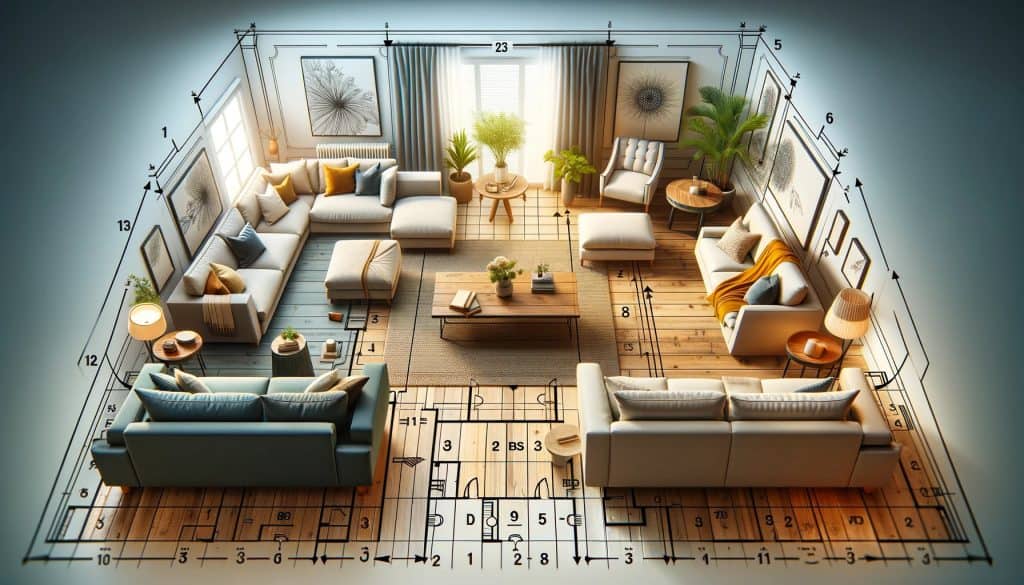
Anchoring the Room’s Layout with a Couch
The couch, more than any other piece of furniture, anchors the layout of a room. It’s not just a seating option; it’s the heart of the living room around which everything else revolves. Its position, orientation, and style set the stage for how the room functions and feels.
The couch often dictates the arrangement of other furniture pieces, like coffee tables, chairs, and entertainment units. Its placement can encourage social interaction, create a cozy atmosphere, or make a style statement.
Exploring Different Types of Couches
Different types of couches serve different purposes and fit into various room layouts:
- Sectional Sofas: Great for large families or those who entertain often. Good placed in spacious rooms, they can define areas in open-plan spaces or fill a large room without making it feel empty.
- Loveseats: Ideal for smaller spaces or as an addition to a larger seating arrangement. They work well in intimate settings or as part of a more extensive seating arrangement.
- Standard Sofas: The most versatile option, standard sofas can fit into almost any living room style or size. They can be the solitary seating option in a small room or part of a larger set in spacious areas.
- Sleeper Sofas: Perfect for those who frequently have guests stay over. They serve a dual purpose without taking up extra space.
- Chesterfield Sofas: Known for their quilted or tufted style, they add a touch of elegance and are often used as a statement piece.
Good Placements for Different Couch Types
- Sectional Sofas: Corner placement works best to utilize space efficiently and facilitate conversation.
- Loveseats: Ideal against a small wall or in a corner, often paired with a standard sofa.
- Standard Sofas: Flexibly placed either against a wall or floating in the middle of the room, depending on the room’s size.
- Sleeper Sofas: Good placed where there’s room to expand without rearranging other furniture.
- Chesterfield Sofas: As a focal point, often in the center of the room or facing a fireplace or TV.
The choice and placement of a couch have a profound impact on a living room’s aesthetics and functionality. By understanding different types of couches and their best placements, you can enhance your living space’s comfort, style, and practicality, making it a true reflection of your lifestyle and tastes.
< class="wp-block-separator has-alpha-channel-opacity"/>Complementing Furniture Choices
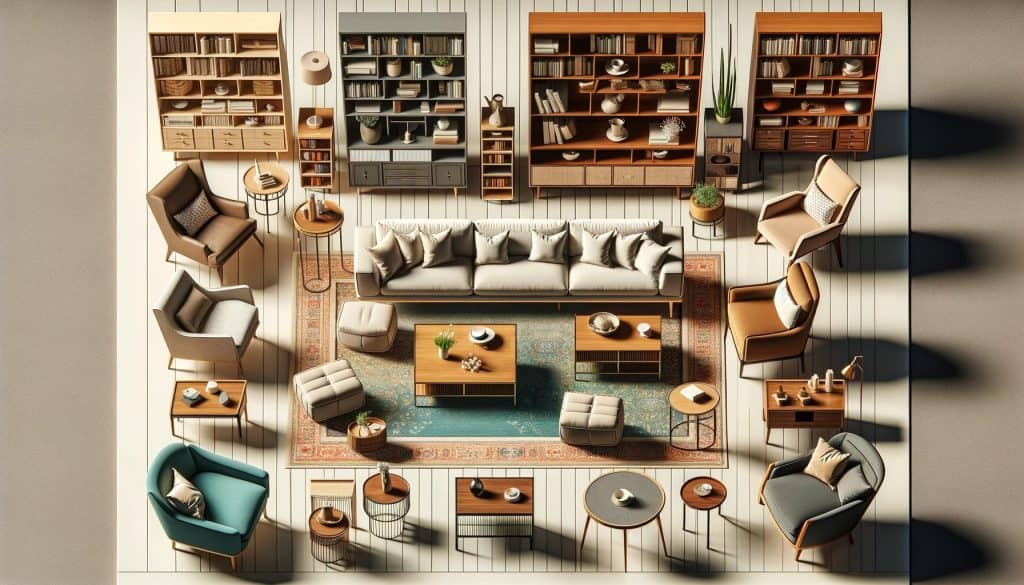
Introduction to Complementary Furniture
Once you’ve chosen the perfect couch, the next step is to select complementary furniture that enhances both the functionality and aesthetic of your living space. These pieces include coffee tables, armchairs, bookshelves, and side tables. The right mix can create a harmonious and inviting atmosphere.
Types of Complementary Furniture
- Coffee Tables: Central to the living room, they should be proportionate to the couch and within easy reach for convenience.
- Armchairs: Great for adding additional seating without the bulk of another sofa. They can either match the couch or add a contrasting element.
- Bookshelves and Side Tables: Functional yet decorative, these can fill empty spaces and offer storage or display areas.
- Ottomans and Benches: Versatile pieces that can serve as additional seating, a footrest, or even a makeshift coffee table.
Selecting Styles and Sizes to Match the Couch and Room
- Style Harmony: Choose furniture that complements the style of your couch. A modern sofa pairs well with sleek, minimalist pieces, while a classic couch might be better suited to more ornate, traditional furniture.
- Size Considerations: The size of complementary furniture should be in proportion to both the couch and the room. Oversized coffee tables can overwhelm a small sofa, just as tiny side tables can look out of place next to a large sectional.
- Color Coordination: Use color to create a cohesive look. This can mean matching hues for a uniform appearance or contrasting colors for a more dynamic vibe.
- Texture and Material: Mixing textures and materials can add depth and interest to your living room. Combine soft fabrics with hard surfaces like wood or metal for a balanced feel.
Choosing the right complementary furniture involves considering both style and functionality. The goal is to create a space that is not only visually appealing but also practical and comfortable. By carefully selecting these pieces, you can enhance the overall ambiance of your living space, making it a perfect reflection of your taste and lifestyle.
< class="wp-block-separator has-alpha-channel-opacity"/>Balancing Function and Form
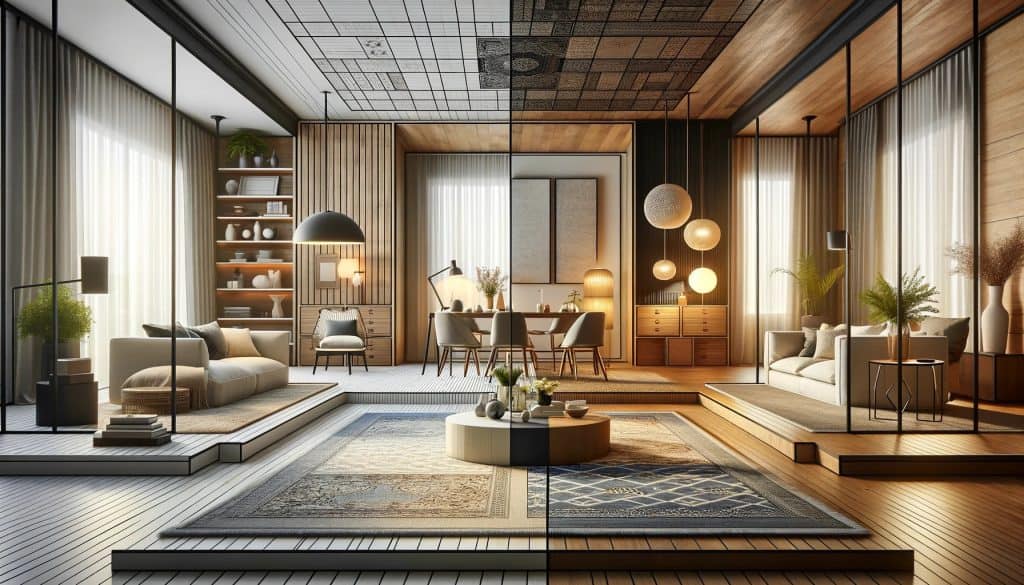
The Interplay of Aesthetics and Practicality
When arranging a living room, the balance between aesthetic appeal and practical use is paramount. A well-designed room should not only be pleasing to the eye but also functional and comfortable for everyday living. This balance is key to creating a space that is both inviting and efficient.
Achieving Aesthetic Appeal
Aesthetically appealing living spaces often feature:
- Harmonious Color Schemes: Colors that complement each other create a visually pleasing environment.
- Thoughtful Decorations: Art pieces, vases, and other decorative items can enhance the room’s beauty.
- Consistent Style Theme: Whether it’s modern, traditional, or eclectic, a consistent style theme ties the room together.
Ensuring Practical Use
Practicality in a living room involves:
- Comfortable Seating: Furniture should be comfortable and accommodate the needs of all household members.
- Easy Movement: There should be clear pathways for movement around and t ough the room.
- Functional Layout: The arrangement of furniture should support the room’s primary uses, whether it’s for relaxation, entertainment, or socializing.
Tips for Balancing Both Elements
- Plan the Layout: Start with a floor plan to ensure a balance of open space and furniture placement.
- Choose Multi-Functional Furniture: Pieces that offer storage or can be used in various ways add functionality without sacrificing style.
- Prioritize Comfort: Select furniture that looks good and offers comfort, like ergonomic chairs and plush sofas.
- Optimize Lighting: Use a mix of natural and artificial lighting to create a warm, inviting atmosphere that’s also practical for various activities.
- Consider Traffic Flow: Arrange furniture to allow for easy movement around the room, avoiding cramped or awkward pathways.
The balance of function and form in a living room is about creating a space that is not only aesthetically pleasing but also practical and comfortable for everyday use. By considering both aspects in your furniture arrangement and decor choices, you can create a living space that is both beautiful and functional, enhancing the quality of your daily life.
< class="wp-block-separator has-alpha-channel-opacity"/>Accessorizing Around the Couch
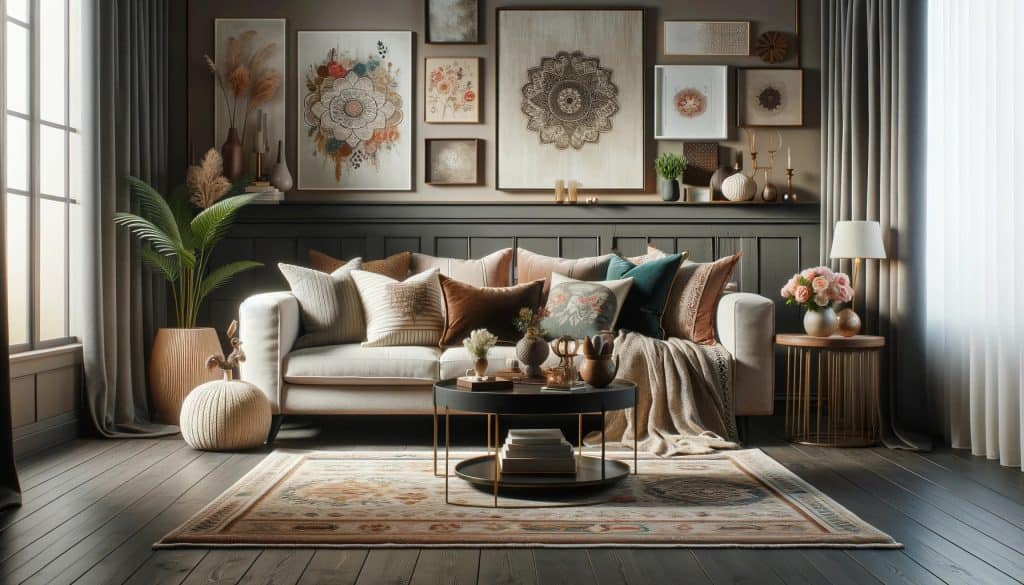
Enhancing Your Living Space with Thoughtful Accessories
Accessorizing around the couch is an art that adds personality and style to your living room. It’s about choosing elements that not only complement the couch but also enhance the overall look of the room. Decorative items like rugs, t ow pillows, and art pieces can transform a simple couch into a stunning focal point.
Ideas for Decorative Elements
- Rugs: A well-chosen rug can anchor the seating area and add warmth and texture. Whether you opt for a bold pattern or a subtle hue, the rug should complement the couch and room’s color scheme.
- T ow Pillows: Pillows are an easy way to introduce color, pattern, and texture. They can be changed seasonally or whenever you want a new look.
- Art Pieces: Hanging art above or near the couch can create a visual focal point. Choose pieces that speak to your style and tie the room’s color palette together.
- Blankets and T ows: A cozy t ow blanket on the couch adds warmth and an inviting touch, perfect for snuggling up on chilly evenings.
How Accessories Enhance the Overall Look
- Color Harmony: Accessories can either match the couch’s color for a monoc omatic scheme or contrast it for a bold statement.
- Texture and Pattern: Mixing textures and patterns adds depth and interest. A smooth leather couch can be paired with soft, plush pillows, while a fabric sofa can be complemented with textured t ows.
- Personal Touch: Accessories are a great way to infuse your personality into the space. Choose items that reflect your interests, travels, or aesthetic preferences.
- Balance and Proportion: Be mindful of scale when accessorizing. Large couches can handle bigger pillows or art pieces, while smaller sofas might benefit from more delicate accessories.
Accessorizing around the couch is a key aspect of room decor. It’s not just about beauty; it’s about creating a space that feels complete and uniquely yours. T ough thoughtful selection of rugs, pillows, art, and other decorative items, you can enhance the aesthetic appeal of your living room, making it a place where style and comfort coexist harmoniously.
< class="wp-block-separator has-alpha-channel-opacity"/>Layout Variations for Different Rooms

Tailoring Living Room Layouts to Space Size and Style
The layout of a living room should be tailored to its size and architectural style. Whether you have a small, medium, or large room, or are working with an open-plan space or an enclosed room, the arrangement of furniture can greatly impact both functionality and aesthetics.
Ideas for Different Room Sizes
- Small Rooms: In smaller spaces, the key is to maximize functionality without overcrowding. Opt for multi-functional furniture, like a sofa bed or nesting tables, and use vertical space for storage. A smaller, sleek couch and wall-mounted shelves can save floor space.
- Medium Rooms: Here, you have more flexibility. You can opt for a standard-sized couch and complement it with a couple of armchairs or a loveseat. A central coffee table can serve as a focal point, with space for additional elements like a bookshelf or a console table.
- Large Rooms: Large rooms offer the luxury of space, allowing for larger sectionals, multiple seating areas, and additional furniture like side tables and floor lamps. You can create distinct zones for different activities, such as a reading nook or a space for entertainment.
Open-Plan Spaces vs. Enclosed Rooms
- Open-Plan Spaces: In an open-plan area, furniture can be used to define different ‘rooms’. A sectional sofa can separate the living area from the dining or kitchen area. Rugs and lighting also help in demarcating spaces without physical barriers.
- Enclosed Rooms: Enclosed rooms provide a defined space where the furniture arrangement can focus on maximizing comfort and aesthetics. The placement of the couch, usually facing a focal point like a fireplace or TV, can dictate the arrangement of other furniture.
Considerations for All Layouts
- Traffic Flow: Ensure there’s enough space for easy movement around the room.
- Balance and Symmetry: Aim for a visually balanced layout, which can be achieved t ough the symmetrical or asymmetrical placement of furniture.
- Focal Points: Identify and utilize natural focal points of the room, arranging furniture to either face or complement them.
The layout of your living room should reflect the size and style of your space. By considering the unique characteristics of your room and applying these layout ideas, you can create a living space that is both functional and aesthetically pleasing, tailored to your lifestyle and preferences.
< class="wp-block-separator has-alpha-channel-opacity"/>The Impact of Lighting and Color
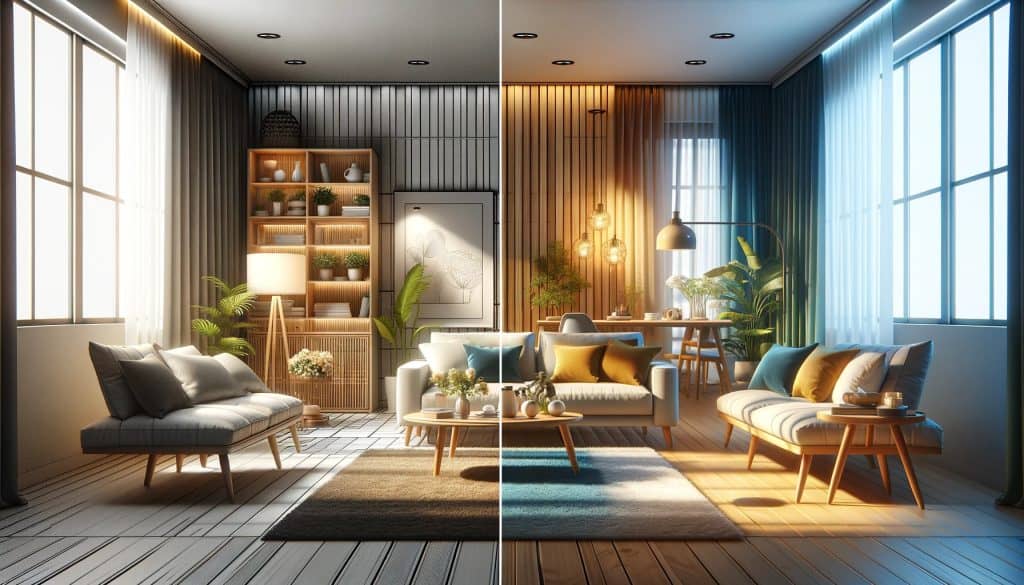
Exploring the Role of Lighting in Furniture Arrangement
The lighting in a room, both natural and artificial, plays a crucial role in furniture arrangement and overall ambiance. It not only affects how we perceive the space but also how we feel in it. Proper lighting can accentuate the beauty of your furniture and decor, creating a warm and inviting atmosphere.
Natural vs. Artificial Lighting
- Natural Lighting: Utilize natural light by arranging furniture to maximize its flow. For instance, placing a reading chair near a window or ensuring the couch receives ample daylight enhances the room’s appeal and functionality.
- Artificial Lighting: Different types of artificial lighting, like floor lamps, table lamps, and overhead fixtures, can be strategically placed to highlight areas of the room and create a cozy ambiance. They also allow for flexibility in using the space at different times of the day.
Influence of Color Schemes
Color schemes can dramatically affect the mood and style of a room. They have the power to either complement or clash with your furniture, impacting the overall aesthetic.
- Complementary Colors: Choosing colors that complement your furniture can create a harmonious and balanced look. For example, a blue couch in a room with soft yellow walls can create a serene and inviting space.
- Contrasting Colors: Bold contrasts can make a dramatic statement. A bright red armchair against a neutral backdrop, for instance, can become an eye-catching focal point.
- Monoc omatic Schemes: Using varying shades of the same color can create depth and sophistication. A grey sofa with lighter and darker grey elements can offer a refined and cohesive look.
Combining Lighting and Color
- Reflective Surfaces: Light-colored walls and reflective surfaces can amplify both natural and artificial light, making a room feel more spacious and open.
- Mood Setting: Use lighting and color to set the desired mood. Warm lights and earth tones can create a cozy atmosphere, while cool lights and vibrant colors can energize a space.
- Focus Areas: Highlight key areas or pieces of furniture with targeted lighting, like spotlights on artwork or table lamps next to a favorite reading spot.
The thoughtful combination of lighting and color can transform a living room. It not only influences the functionality and aesthetic appeal of the furniture arrangement but also sets the mood and character of the space. By considering these elements, you can create a living room that is not only beautiful but also a true reflection of your personal style and comfort.
< class="wp-block-separator has-alpha-channel-opacity"/>Conclusion: Creating Your Personalized Living Space
As we conclude our journey t ough the art of arranging furniture around the couch, let’s recap the key points and ideas that can transform your living space:
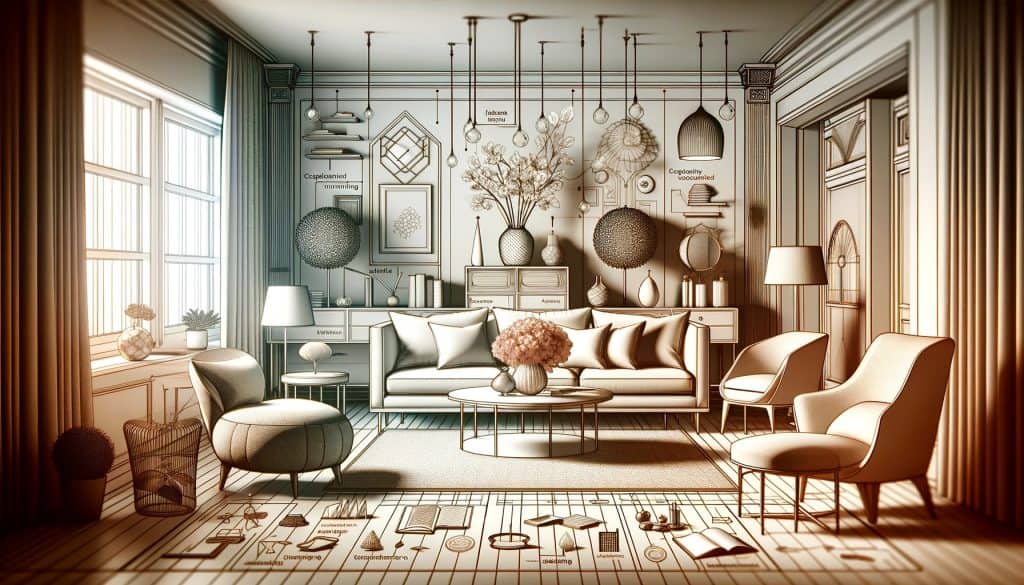
- The Couch as a Central Piece: Remember, the couch is often the focal point around which the rest of the room is arranged. Its style, placement, and comfort level set the tone for the entire living area.
- Complementing Furniture Choices: Choosing the right complementary furniture pieces like coffee tables, armchairs, and bookshelves is crucial in enhancing the functionality and aesthetic of the room.
- Balancing Function and Form: Strive for a balance between aesthetic appeal and practical use. Your living space should not only look good but also be comfortable and functional for everyday activities.
- Accessorizing Around the Couch: Use accessories like rugs, t ow pillows, and art pieces to add personality and depth to your living space. These elements can significantly enhance the overall look and feel of the room.
- Layout Variations for Different Rooms: Tailor your furniture arrangement to the size and style of your room, whether it’s small, medium, or large, open-plan or enclosed.
- The Impact of Lighting and Color: Understand how lighting and color schemes can dramatically affect the mood and style of your living room. They play a vital role in highlighting your furniture and decor.
With these insights, I encourage you to experiment and personalize your furniture arrangement. Every living space is unique, and the beauty of interior design lies in its flexibility and capacity for personalization. Don’t be afraid to try different layouts, play with colors, and mix and match furniture until you find the perfect arrangement that reflects your style and meets your needs.
Remember, your living space is a reflection of your personality and lifestyle. By thoughtfully arranging your furniture, choosing the right accessories, and considering the impact of lighting and color, you can create a space that is not only visually appealing but also a comfortable and inviting haven for you and your loved ones.


